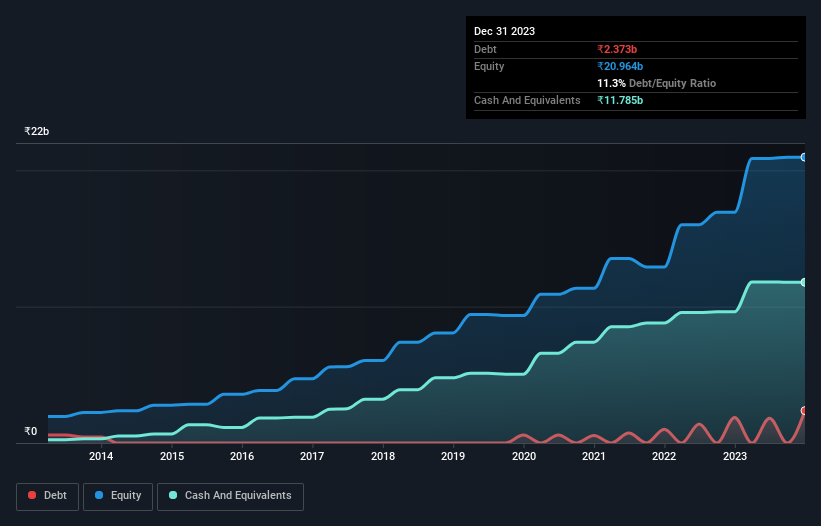
Some say volatility, rather than debt, is the best way to think about risk as an investor, but Warren Buffett famously said that 'Volatility is far from synonymous with risk.' It's only natural to consider a company's balance sheet when you examine how risky it is, since debt is often involved when a business collapses. We note that Tata Elxsi Limited (NSE:TATAELXSI) does have debt on its balance sheet. But should shareholders be worried about its use of debt?
When Is Debt A Problem?
Debt is a tool to help businesses grow, but if a business is incapable of paying off its lenders, then it exists at their mercy. Ultimately, if the company can't fulfill its legal obligations to repay debt, shareholders could walk away with nothing. However, a more usual (but still expensive) situation is where a company must dilute shareholders at a cheap share price simply to get debt under control. By replacing dilution, though, debt can be an extremely good tool for businesses that need capital to invest in growth at high rates of return. When we think about a company's use of debt, we first look at cash and debt together.
Check out our latest analysis for Tata Elxsi
How Much Debt Does Tata Elxsi Carry?
You can click the graphic below for the historical numbers, but it shows that as of September 2023 Tata Elxsi had ₹2.37b of debt, an increase on ₹1.87b, over one year. However, it does have ₹11.8b in cash offsetting this, leading to net cash of ₹9.41b.

A Look At Tata Elxsi's Liabilities
Zooming in on the latest balance sheet data, we can see that Tata Elxsi had liabilities of ₹4.61b due within 12 months and liabilities of ₹2.56b due beyond that. Offsetting these obligations, it had cash of ₹11.8b as well as receivables valued at ₹8.85b due within 12 months. So it actually has ₹13.5b more liquid assets than total liabilities.
This short term liquidity is a sign that Tata Elxsi could probably pay off its debt with ease, as its balance sheet is far from stretched. Succinctly put, Tata Elxsi boasts net cash, so it's fair to say it does not have a heavy debt load!
And we also note warmly that Tata Elxsi grew its EBIT by 11% last year, making its debt load easier to handle. There's no doubt that we learn most about debt from the balance sheet. But it is future earnings, more than anything, that will determine Tata Elxsi's ability to maintain a healthy balance sheet going forward. So if you want to see what the professionals think, you might find this free report on analyst profit forecasts to be interesting.
Finally, while the tax-man may adore accounting profits, lenders only accept cold hard cash. While Tata Elxsi has net cash on its balance sheet, it's still worth taking a look at its ability to convert earnings before interest and tax (EBIT) to free cash flow, to help us understand how quickly it is building (or eroding) that cash balance. Over the most recent three years, Tata Elxsi recorded free cash flow worth 58% of its EBIT, which is around normal, given free cash flow excludes interest and tax. This free cash flow puts the company in a good position to pay down debt, when appropriate.
Summing Up
While we empathize with investors who find debt concerning, you should keep in mind that Tata Elxsi has net cash of ₹9.41b, as well as more liquid assets than liabilities. So is Tata Elxsi's debt a risk? It doesn't seem so to us. Over time, share prices tend to follow earnings per share, so if you're interested in Tata Elxsi, you may well want to click here to check an interactive graph of its earnings per share history.
When all is said and done, sometimes its easier to focus on companies that don't even need debt. Readers can access a list of growth stocks with zero net debt 100% free, right now.
Valuation is complex, but we're here to simplify it.
Discover if Tata Elxsi might be undervalued or overvalued with our detailed analysis, featuring fair value estimates, potential risks, dividends, insider trades, and its financial condition.
Access Free AnalysisHave feedback on this article? Concerned about the content? Get in touch with us directly. Alternatively, email editorial-team (at) simplywallst.com.
This article by Simply Wall St is general in nature. We provide commentary based on historical data and analyst forecasts only using an unbiased methodology and our articles are not intended to be financial advice. It does not constitute a recommendation to buy or sell any stock, and does not take account of your objectives, or your financial situation. We aim to bring you long-term focused analysis driven by fundamental data. Note that our analysis may not factor in the latest price-sensitive company announcements or qualitative material. Simply Wall St has no position in any stocks mentioned.
About NSEI:TATAELXSI
Tata Elxsi
Engages in the provision of product design and engineering, and systems integration and support services in India, the United States, Europe, and internationally.
Flawless balance sheet established dividend payer.


